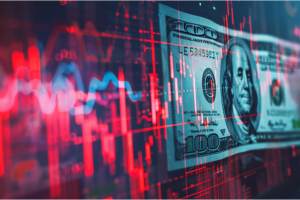
Today’s bull/bear narratives … Luke’s market prediction … what could derail stocks next year … the bullish case for Trump … short-term gains with Louis Navellier
Two broad narratives are taking shape as investors look ahead to the markets in 2025…
The bullish narrative is that stocks are going to roar higher on the back of AI and technology spending, corporate tax cuts and deregulation from Trump, and the elimination of government waste led by Elon Musk and Vivek Ramaswamy.
The bearish narrative is that we’re in the final innings of an epic bull run, but a resurgence of inflation combined with a misstep from the Fed will topple our stock market, which by some measures, has the most expensive valuation ever.
Last week, our technology expert Luke Lango offered a valuable roadmap for investors trying to navigate these conflicting visions:
Overall, we’re maintaining our “short-term cautious, medium-term bullish, long-term mixed” stance on the markets.
Short-term (daily/weekly basis), the market needs to cool off. It is due for either a consolidation or pullback in November – before a rebound rally in December.
Medium-term (monthly/yearly basis), the combination of falling interest rates, pro-growth policies, and strong earnings should propel stocks meaningfully higher in 2025 and maybe even into 2026/27.
Long-term (multi-year basis), this market boom will end in a bust.
We are working on our second consecutive >20% return year for the S&P 500. We think we could get another one in 2025.
That would be three consecutive >20% return years for the market. That only has one precedent – the late 1990s. And that ended with the Dot Com Crash.
Be aware of this risk.
With this as our working guide, let’s walk through a few hypotheticals and “what if’s?” to provide us a better sense of the risks/opportunities as we look to 2025.
Starting with today’s nosebleed market valuation, could it derail stocks sooner than Luke predicts?
Regular Digest readers are very aware of how expensive our stock market is today. In recent months, I’ve highlighted several indicators and valuation metrics supporting this point.
But it’s important to note that expensive valuations alone don’t mean an impending bear market. Last week, billionaire hedge fund manager David Einhorn, founder of Greenlight Capital, made this point:
This is the most expensive market of all time. This is a really, really pricey environment, but it doesn’t necessarily make me bearish…
An overvalued stock market is not necessarily a bear market, and it doesn’t necessarily mean it has to go down anytime soon.
I’m not particularly bearish; I can’t really see what’s going to break the market at this time.
Building on Einhorn’s point, an expensive stock market is a bit like a forest littered with dead trees and dry leaves.
Yes, the risk of a destructive forest fire is elevated because of all this latent fuel lying around, but you still need the lightning strike or careless match to ignite the blaze. Without it, the fuel can continue piling up for years underneath sunny skies.
So, what’s the most likely lightning strike today?
It would likely be a succession of strikes…
They would begin with a surprise resurgence of inflation (maybe not a surprise if you’ve been tracking the month-to-month data as we’ve been doing here in the Digest) …
Trump’s proposed tax cuts and deregulations (exacerbated by rate cuts from the Fed) would then act as gasoline, fueling a roaring resurgence in inflation…
This would force the Fed to U-turn on its rate policy. Rather than give Wall Street and Main Street a succession of interest rate cuts, the Fed holds them steady. Under a worst-case scenario, they have to raise rates.
Wall Street finds itself on its heels. After having bid up prices to egregiously high valuations in expectation of Goldilocks conditions, we see a violent repricing lower as expectations meet reality.
Now, stepping back, even if this plays out, it would likely be mid-Q1 or maybe Q2 2025 before we’d have enough evidence that the initial lightning strike of reinflation is happening to spook the markets.
Yes, we’ll likely see some hotter than expected inflation prints in the coming months, but Wall Street’s (and the Fed’s) kneejerk reaction will be to write them off as “bumps” within a broader succession of downward inflation.
This is what happened at the start of 2024. You’ll recall that we had multiple months of “surprise” inflation to the upside. The Fed and Wall Street called them “blips.”
Finally, in April, too many blips had piled up. The market panicked, sending the Nasdaq down 7% in about three weeks.
This is our risk today, though on a far greater scale.
But could Trump’s tax cuts and deregulation result in a rosier outcome?
Absolutely.
The financial media are rushing to predict Trump-based inflation is on the way. But let’s rewind to Econ 101. What causes inflation?
Simplistically, it’s when we have too much money supply outpacing economic productivity.
While the media are focusing on the money supply part of this (corporate and personal tax cuts will juice economic spending, leading to inflation), they’re mostly silent about the economic productivity part of the equation.
But in a rosy scenario, tax cuts and deregulation increase demand for goods and services… business investment increases… hiring increases… wage growth increases… so, overall productivity skyrockets.
In the ideal outcome, no, prices won’t come down (they’re entrenched at this point); but wages and economic opportunities will rise to match them, and then some. So, the net effect would be that some Trump-based price inflation is offset by a tsunami of economic productivity. Main Street America feels stronger financially, and confidence increases.
Meanwhile, corporate America sees stronger earnings hitting their bottom lines. This takes pressure of today’s nosebleed stock valuations.
And over in the government sector, all that potential new inflation that the media predicts will stem from heavy Trump spending would be offset by Musk and Ramaswamy cutting off the fat from our bloated government bureaucracy.
Translation – the build-up of dead trees and leaves in the forest stops. Best case, we even remove some of it.
Louis Navellier’s favorite economist, Ed Yardeni, believes this is closer to our likely outcome
Let’s go to Yardeni:
We believe that Trump 2.0 represents a major regime change from Biden 1.0 (or was that Obama 3.0?).
The corporate tax rate will be lowered from 21% to 15%. Personal income from tips, overtime, and Social Security might not be taxed. Many onerous regulations on business will be eliminated…
We expect that better economic growth will boost federal government revenues and that Elon Musk will succeed in slowing the growth in federal government spending. GDP growth might actually keep pace with mounting government debt…
So, we are changing the subjective probabilities of our three scenarios as follows: Roaring 2020s (55%, up from 50%), 1990s-style meltup (25%, up from 20%), and 1970s-style geopolitical and/or domestic debt crisis (20%, down from 30%).”
While this is bullish, let’s be clear…
A 20% chance of a 1970s-style debt crisis is hardly insignificant. And Yardeni is quick to point toward Fed officials who are “oddly oblivious to the strength of the economy, the backup in bond yields, and the outlook for more fiscal stimulus” as they proceed down the rate-cut path.
So, while optimistic, we maintain our caution, aware of the risks of a Fed misstep. That said, the potential for economic growth from the Trump administration is supportive of Luke’s medium-term outlook. Here it is as a reminder:
The combination of falling interest rates, pro-growth policies, and strong earnings should propel stocks meaningfully higher in 2025 and maybe even into 2026/27.
What do we do about the long-term and short-term?
Like Luke, we see a crash coming…eventually.
But between now and then, Trump could be a gamechanger, so we want to remain invested.
As always, we urge you to be mindful of your stop-losses, position sizing, and now, the need for your portfolios to reflect Trump policies (we’ll address this in a different Digest), but the benefit of the doubt goes to a continuation of bullishness, refreshed by Trump 2.0.
That said, if you disagree and don’t want to have your wealth exposed to this market for too long, I’d point you to Louis Navellier’s Quantum Cash system.
With Quantum Cash, Louis leverages his computer systems to help him find fundamentally superior stocks that are surging right now, providing investors with the potential for double- or triple-digit gains in a matter of just weeks or months.
Here’s Louis:
Last week, another one of my top Accelerated Profits stocks doubled after crushing analysts’ earnings estimates by 228% and increasing its outlook for fiscal year 2024. As a result, the stock surged 102% last week.
That brought our current return to roughly 200% in only nine weeks!
These earnings might have taken Wall Street by surprise, but I knew they were coming… and it’s all thanks to my Quantum Cash system.
We’re running long, so to learn more about Quantum Cash, click here for Louis’ full presentation.
Bottom line: If sniper-like returns (rather than buy-and-hold) is more your preference in today’s market – or if you just want to focus on fast returns – it’s worth your time to check out Louis’ approach.
Circling back to Luke’s roadmap…
It feels accurate. Of course, the timing of the distinction between “short, medium, and long” is the wildcard.
While no one knows those details, we don’t believe we’re at the top yet. So, let’s make money while we can.
Be careful…but stick with bullishness.
Have a good evening,
Jeff Remsburg






